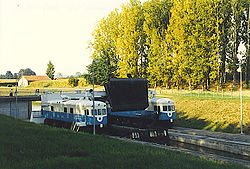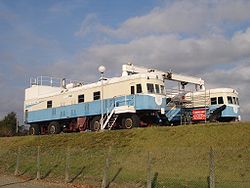- Montech water slope
-
The Montech water slope is a type of canal inclined plane built on the Canal de Garonne, in the commune of Montech, Tarn-et-Garonne, South West France. It is managed by the publicly-owned Voies navigables de France and it replaced a group of five successive locks.
Contents
Operating Principles
The principle of the water slope is based on a sloping channel up or down which a wedge of water retained by a water tight gate is moved. This technique was invented in the 19th century by the German engineer Julius Greve and described by the French engineer Jean Aubert [1] in 1961.[2][3] The Montech water slope was inaugurated in July 1974.
A sloping concrete channel is continuously fed by a small stream of water. A movable gate spans the channel. The points of contact of the gate with the channel are tight but not fixed. Two adapted diesel locomotives, one on either side of the channel support the gate.
To allow a boat to ascend: the gate is lifted, the boat enters the channel, and then the gate is lowered. This isolates the wedge of water, on which the boat is floating, from the canal it has left. The locomotives ascend the slope pushing the water wedge in front of the movable gate. The boat rides on the water wedge.
Animation - Click on « comment ça marche » (or go directly to the animation)
Details of the machinery
By its power and ingenuity the slope engine is the key to the system. It consists of:
- The two locomotives rigidly connected together by a cross piece which spans the channel with the locomotives travelling on the channel's banks.
- The gate acts as a big valve connected to the rigid cross member by an arm.
- A horizontal beam serving as a shock absorber between the boats and the gate.
Each diesel electric locomotive develops 1,000 horsepower (750 kW) distributed to four drive motors, one on each of the four axles each with two large pneumatic tyres.
The three contact faces of the gate with the channel are equipped with seals to keep the wedge of water in place. The gate is raised or lowered using a hydraulic ram.
The shock absorber is a hydraulically-levelled hinged metal frame. It allows boats to be moored to the gate during ascents and descents. An electronic system keeps motion gentle and smooth. Finally triple brakes slow the system without jerks.
Benefits
The water slope allows the five locks it replaced to be bypassed. These locks are still in use, mainly to allow the passage of pleasure boats. The water slope is reserved for boats 30 to 40m in length and ascends or descends in 20 minutes, 45 minutes faster than the passage of the five locks.
Design features
- Weight of the engines: 200 tonnes
- Pushing effort: 60 tonnes
- Speed : 4.5 km/h
- Volume of water moved : 1,500 m³
- Slope of the channel : 3 %
- Height of the slope: 13.30 m
- Depth of water wedge moved: 3.75 m
- Length of the water wedge : 125 metres
- Power of the locomotives: 2 x 1,000 hp (750 kW)
- Length of the channel: 443 m
- Width of the channel: 6 m
- Duration of passage: about 6 minutes
- Length, width and capacity of the boats : 38.5m, 5.5m and 250 tonnes.
See also
- Fonserannes water slope
- Garonne
- Canal du Midi
- Original French article from which this article was translated
Further reading
- Uhlemann, Hans-Joachim (2002). Canal Lifts and Inclines of the World (Softback ed.). Internat. ISBN 0-9543-181-1-0.
- Hadfield, Charles (1986). World Canals (First ed.). David & Charles. ISBN 0-7153-8555-0.
References
- ^ Rolt, L. T. C. (1973). From Sea to Sea. Ohio University Press. ISBN 8124-0152-1.
- ^ Lance Day; Ian McNeil. Biographical Dictionary of the History of Technology. http://books.google.com/books?id=qNp3JM35UMoC&pg=PA29&dq=Jean+Aubert+canal&lr=&cd=1#v=onepage&q=Jean%20Aubert%20canal&f=false.
- ^ Ian McNeil. An Encyclopaedia of the history of technology. http://books.google.com/books?id=uxsOAAAAQAAJ&pg=PA485&dq=Jean+Aubert+canal&lr=&cd=2#v=onepage&q=Jean%20Aubert%20canal&f=false.
External links
Coordinates: 43°58′13″N 1°13′39″E / 43.97028°N 1.2275°E
Photos
Categories:- Canal inclined planes
- Locks of France
Wikimedia Foundation. 2010.










